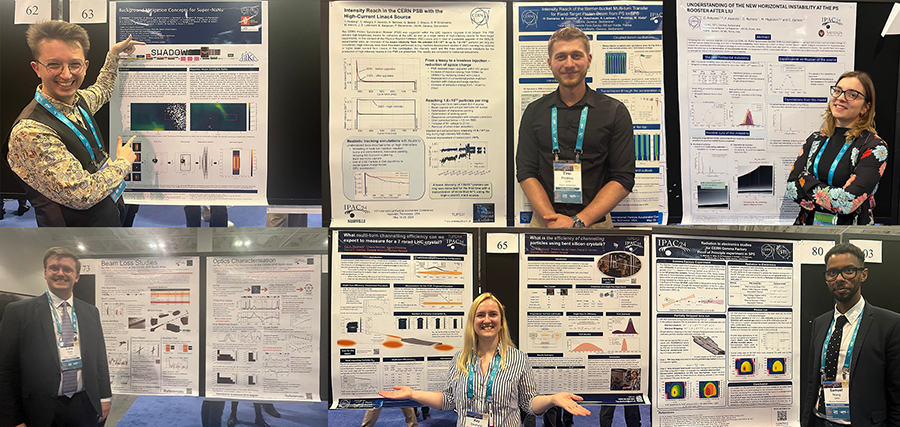
Every year, accelerator physicists gather at IPAC to highlight their work and discuss the latest developments at the forefront of accelerator physics. This year, PBC made a strong contribution with 11 posters presented by seven of its members.
Several posters focused on feasibility studies for projects in CERN’s North Area, including the high-intensity proton delivery required by the as recently approved SHiP (Search for Hidden Particles) experiment which will search for rare processes and new particles at CERN’s North Area of the Super Proton Synchrotron (SPS). Luke Dyks (CERN) summarised on his posters initial findings for redesigning the corresponding the P42 beamline to handle the high-intensity proton beams by optimising the transmission efficiency thanks to new beam instrumentation.
These feasibility studies further include the reduction of the muon background for high intensity experiments for hidden sector or neutrino physics studies. Florian Stummer (University of Vienna) demonstrated a general study on the example of the NaNu (North Area NeUtrino) detector of the proposed SHADOWS (Search for Hidden And Dark Objects With the SPS) experiment. At NaNu, neutrinos would be detected in emulsion films similar to FASERν. The installation of an O-shaped magnet would decrease the muon background significantly and increase the longevity of the emulsion films as well as the overall cost efficiency of the experiment.
The LHC Injectors Upgrade (LIU) has opened the possibility to increase the intensity of the beams for fixed-target experiments like SHiP. Tirsi Prebibaj (CERN) reviewed the studies that allowed to increase by more than 50% the intensity at the Proton Synchrotron Booster (PSB), matching prior simulations and boding well for an SPS intensity increase. These results have also benefitted of the detective work conducted by Chiara Antuono (CERN & University of Roma La Sapienza) to determine the source of a beam instability observed in the PSB since 2021.
The NA61/SHINE experiment has submitted a proposal to explore the onset of the quark-gluon plasma fireball, extending the scan in the momentum/ion specie space with fixed-target collision of light ion beams. The LHC might also gain from a higher integrated nucleon-nucleon luminosity potentially achieved by ions lighter than lead. Elias Waagaard (CERN and EPFL) and his colleagues studied beam-brightness and intensity limitations to assess performance capabilities of the CERN ion injector chain for light ions. He compared tracking simulation results for the PS and SPS with Pb beam data in the ion injectors to predict the optimal ion species for a maximum performance out of the ion injector chain.
Kay Dewhurst (CERN) highlighted in her poster presentations both simulations and first tests of a novel double-crystal experiment that is being considered for installation in the LHC to measure precession properties of short-lived baryons such as the Λc+. The two crystals enhance beam manipulation: while the first crystal bends and focuses the particles, the second acts as a spin analyser, which allows the precise measurement of the Λc+ decay product’s angular distribution and polarisation. The method uses protons from the beam halo, which are stray particles around the beam which do not contribute to luminosity. By using particle tracking programs, Kay and her colleagues predicted the performance of prototype crystals that have been successfully tested in CERN’s North Area at 180 GeV in autumn 2023, and that are planned to be installed in the LHC in early 2025.
The proposed Gamma Factory experiment (GF) aims to produce high-intensity photon beams in the energy domain up to 400 MeV in the LHC. By colliding lasers with ultra-relativistic atomic beams of Partially Stripped Ions (PSI), the experimentalists seek to achieve a resonant excitation of the atoms, resulting in a spontaneous emission of high-energy photons. The same principle might allow to increase the brightness of the ion beams delivered to the LHC. A proof-of-principle experiment is being planned to study the GF scheme generating X-rays in the range of keV from lithium-like lead PSI stored at the SPS. Peter Martin Kruyt (CERN and Goethe University, Frankfurt) and Samuel Niang (CERN) presented first laser cooling simulations, including emittance reduction, the required laser power and radiation effect studies to ensure compliance with general limits on radiation to electronics.
With this glimpse from its diverse portfolio, PBC is looking forward to presenting more of these results and to turn them into reality soon.